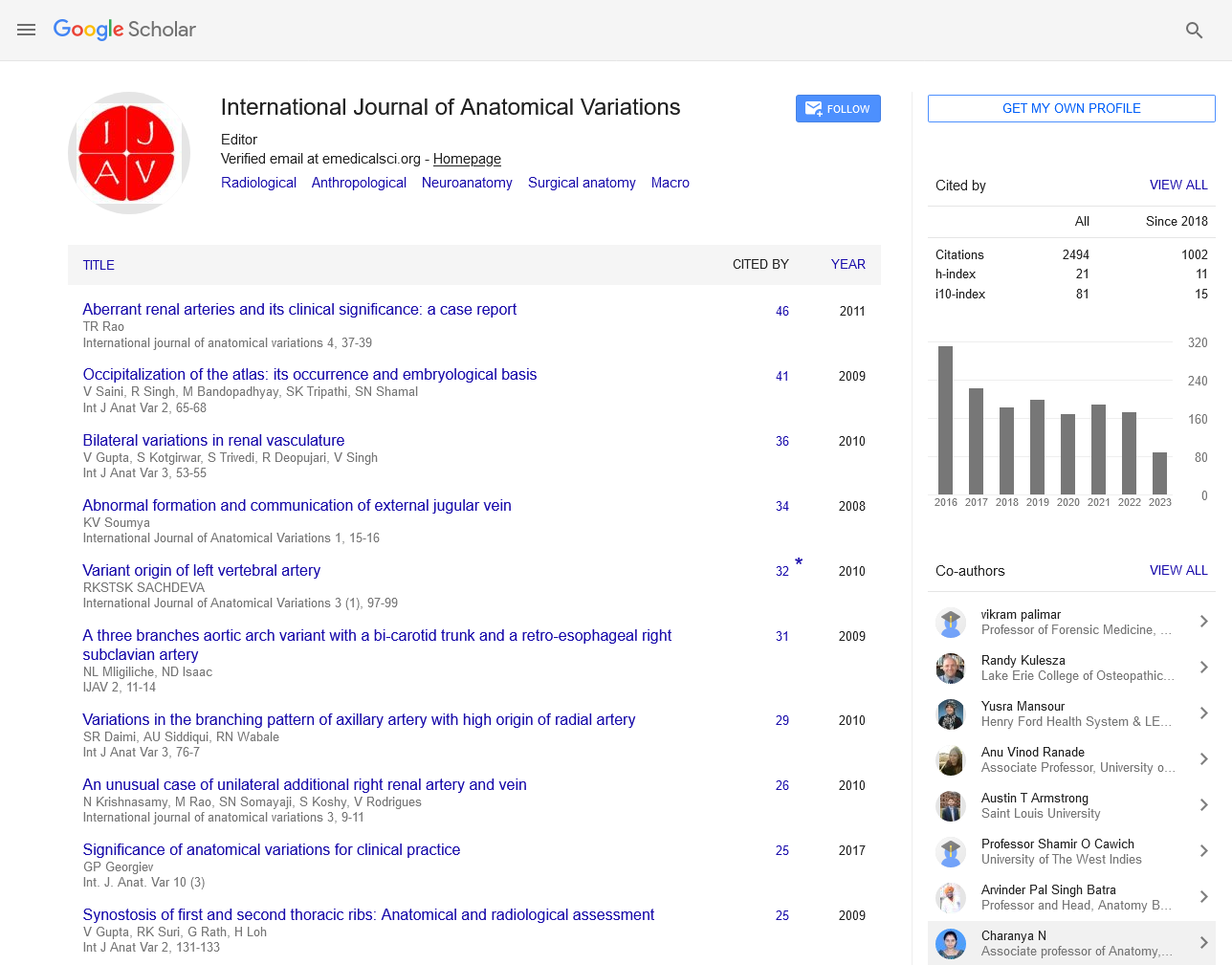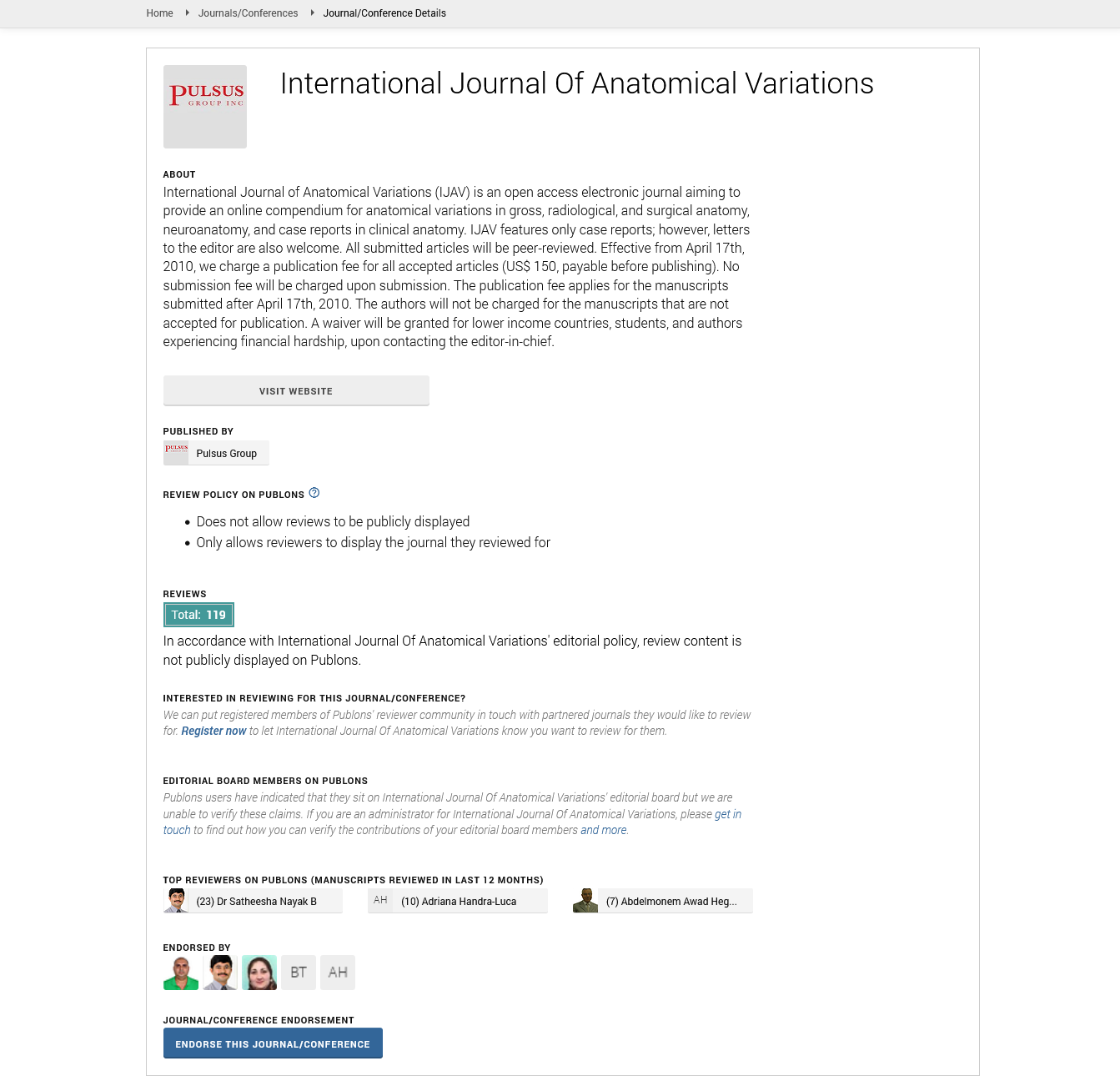The Impact of Anatomical Variations on Imaging Techniques and Outcomes
Received: 03-Sep-2024, Manuscript No. ijav-24-7299; Editor assigned: 05-Sep-2024, Pre QC No. ijav-24-7299; Reviewed: 19-Sep-2024 QC No. ijav-24-7299; Revised: 24-Sep-2024, Manuscript No. ijav-24-7299; Published: 30-Sep-2024, DOI: 10.37532/1308-4038.17(9).434
This open-access article is distributed under the terms of the Creative Commons Attribution Non-Commercial License (CC BY-NC) (http://creativecommons.org/licenses/by-nc/4.0/), which permits reuse, distribution and reproduction of the article, provided that the original work is properly cited and the reuse is restricted to noncommercial purposes. For commercial reuse, contact reprints@pulsus.com
Abstract
Anatomical variations among individuals significantly influence the effectiveness and accuracy of imaging techniques used in clinical practice. This paper explores the impact of these variations on modalities such as X-rays, computed tomography (CT), magnetic resonance imaging (MRI), and ultrasound. By examining common anatomical anomalies—such as variations in vascular structures, organ placement, and bone morphology—we highlight how these differences can lead to diagnostic challenges, misinterpretations, and variations in treatment outcomes. Furthermore, the paper discusses the implications of anatomical variations for the development of imaging protocols and the necessity for radiologists and clinicians to maintain a high degree of awareness regarding individual patient anatomy. We also propose strategies for improving diagnostic accuracy, including the use of advanced imaging technologies and tailored imaging approaches. Ultimately, this review underscores the importance of recognizing and accommodating anatomical diversity in imaging practices to enhance patient care and treatment efficacy.
INTRODUCTION
Anatomical variations are inherent in the human body, with studies suggesting that no two individuals possess the exact same anatomical structure. These variations can be classified as either normal variant, which occur within the range of anatomical diversity, or pathological anomalies that arise due to developmental, genetic, or environmental factors. The presence of such variations has profound implications for medical imaging, a field heavily reliant on precise anatomical landmarks for accurate diagnosis and treatment planning [1].
Imaging techniques, including X-rays, computed tomography (CT), magnetic resonance imaging (MRI), and ultrasound, are crucial in modern medicine for visualizing internal structures and guiding interventions. However, anatomical variations can complicate these imaging modalities, leading to potential misinterpretations and diagnostic errors. For example, variations in the branching patterns of vascular structures may obscure critical pathology, while atypical organ locations can hinder the identification of tumors or other abnormalities [2].
Additionally, anatomical variations may contribute to disparities in treatment outcomes, as clinicians may inadvertently overlook or misdiagnose conditions due to a lack of awareness of individual anatomical differences. As such, there is a pressing need for healthcare professionals, particularly radiologists and clinicians, to recognize and understand these variations to enhance diagnostic accuracy and optimize patient management.
This paper aims to explore the multifaceted impact of anatomical variations on imaging techniques and outcomes, emphasizing the importance of individualized approaches in medical imaging [3]. By examining the challenges posed by anatomical diversity and proposing strategies to mitigate these issues, we hope to contribute to the ongoing discourse on improving diagnostic efficacy and patient care in the realm of medical imaging.
DISCUSSION
Anatomical variations are an intrinsic aspect of human biology, and their implications for medical imaging cannot be overstated. As imaging technologies continue to evolve and become integral to diagnosis and treatment, understanding the effects of these variations is paramount for improving clinical outcomes.
One of the primary challenges posed by anatomical variations is the risk of misinterpretation in imaging results. For instance, vascular anomalies such as aberrant coronary artery patterns or variations in the hepatic vascular system can significantly alter the appearance of structures on CT or MRI scans. Such variations may lead to incorrect assumptions about pathology, especially in acute settings where timely diagnosis is crucial [4,5]. Studies have demonstrated that knowledge of common anatomical variations can enhance the diagnostic accuracy of radiologists, underscoring the need for ongoing education and training in this area.
Moreover, the diversity in organ size, shape, and location can complicate the application of standardized imaging protocols. For example, in ultrasound imaging, variations in renal anatomy can affect the visualization of kidney stones or masses. Similarly, differences in breast density and composition can influence mammography outcomes, impacting the detection rates of breast cancer. This variability necessitates a tailored approach to imaging that takes individual anatomical differences into account, potentially involving adjustments in technique or the use of supplementary imaging modalities [6].
The interplay between anatomical variations and imaging outcomes extends beyond diagnosis to treatment planning and intervention. Surgical approaches often rely on precise anatomical landmarks identified through imaging. However, if these landmarks are obscured or misrepresented due to anatomical variations, it can lead to complications during procedures. For example, variations in the anatomy of the spine can complicate spinal surgeries, making preoperative imaging critical for successful outcomes. This highlights the necessity of comprehensive imaging assessments that consider potential anatomical diversity to enhance surgical precision and minimize risks [7,8].
Furthermore, the advent of advanced imaging technologies, such as three-dimensional (3D) imaging and personalized imaging algorithms, holds promise for addressing the challenges posed by anatomical variations. These technologies enable more accurate reconstructions of individual anatomy, allowing clinicians to visualize variations that traditional imaging may overlook. Implementing these advanced techniques could lead to improved diagnostic accuracy and patient-specific treatment plans, ultimately enhancing clinical outcomes [9].
In conclusion, anatomical variations present significant challenges in medical imaging, impacting diagnostic accuracy and treatment efficacy. By fostering a deeper understanding of these variations and integrating advanced imaging techniques, healthcare professionals can better navigate the complexities of individual anatomy, thereby improving patient care. Ongoing research and education in this area are essential to equip clinicians with the knowledge and tools necessary to address the diverse anatomical landscape encountered in clinical practice [10].
CONCLUSION
Anatomical variations are a fundamental aspect of human biology that profoundly affects medical imaging techniques and clinical outcomes. These variations can lead to challenges in diagnosis, treatment planning, and procedural interventions, often resulting in misinterpretations and potential complications. As imaging technologies advance and become increasingly integral to patient care, the need to understand and accommodate anatomical diversity becomes even more critical.
Recognizing the impact of anatomical variations allows healthcare professionals, particularly radiologists and clinicians, to refine their imaging practices and enhance diagnostic accuracy. Education and training focused on common anatomical anomalies, alongside the implementation of tailored imaging protocols, can significantly mitigate the risks associated with misinterpretation and improve overall patient outcomes.
The integration of advanced imaging modalities, such as 3D imaging and personalized algorithms, offers promising avenues for overcoming the limitations imposed by anatomical variations. By leveraging these technologies, clinicians can achieve a more comprehensive understanding of individual patient anatomy, leading to more precise diagnostics and more effective treatment plans.
In summary, addressing the impact of anatomical variations on imaging techniques is essential for optimizing patient care. By fostering a culture of awareness and adaptability within the medical imaging field, we can better navigate the complexities of individual anatomy, ultimately enhancing diagnostic accuracy, improving treatment outcomes, and ensuring safer, more effective patient management.
REFERENCES
- Cui RR, Wright JD, Hou JY. Uterine leiomyosarcoma: a review of recent advances in molecular biology, clinical management and outcome.BJOG: Int. J Obstet Gynaecol. 2017; 124(7):1028–1037.
- Santos P, Cunha TM. Uterine sarcomas: Clinical presentation and MRI features.Diagnostic and Interventional Radiology. 2015; 21(1):4–9.
- Cree IA, Tan PH, Travis WD, Wesseling Pet al.Counting mitoses: SI (ze) matters!Modern Pathology. 2021; 34:1651–1657.
- Mayerhofer K, Obermair A, Windbichler G, Petru Eet al.Leiomyosarcoma of the uterus: A clinicopathologic multicenter study of 71 cases.Gynecol Oncol. 1999; 74(2):196–201.
- Arend RC, Toboni MD, Montgomery AM, Burger RAet al.Systemic Treatment of Metastatic/Recurrent Uterine Leiomyosarcoma: A Changing Paradigm.Oncologist. 2018; 23(12):1533–1545.
- Damerell V, Pepper MS, Prince S. Molecular mechanisms underpinning sarcomas and implications for current and future therapy.Signal Transduction and Targeted Therapy. 2021; 6(1).
- George S, Serrano C, Hensley ML, Ray-Coquard I. Soft tissue and uterine Leiomyosarcoma.Journal of Clinical Oncology. 2018; 36(2):144–150.
- Zhang G, Yu X, Zhu L, Fan Q et al. Preoperative clinical characteristics scoring system for differentiating uterine leiomyosarcoma from fibroid.BMC Cancer. 2020; 20(1).
- Huang YT, Huang YL, Ng KK, Lin G. Current status of magnetic resonance imaging in patients with malignant uterine neoplasms: A review.KJR. 2019; 20(1):18–33.
- Hughes L, Roex A, Parange A. STUMP, a surprise finding in a large fibroid uterus in a 20-year-old woman.Int J Womens Health. 2018; 10:211–214.
Indexed at, Google Scholar, Crossref
Indexed at, Google Scholar, Crossref
Indexed at, Google Scholar, Crossref
Indexed at, Google Scholar, Crossref
Indexed at, Google Scholar, Crossref
Indexed at, Google Scholar, Crossref
Indexed at, Google Scholar, Crossref
Indexed at, Google Scholar, Crossref
Indexed at, Google Scholar, Crossref






